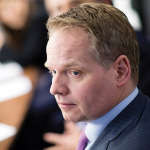It’s fair to say that Legal Business has long been sceptical of the prospects for listed UK law firms, and none more so than the most hyped of the lot, DWF. ‘The 2020s still look likely to end with public markets as a marginal force in global law,’ noted our recent cover feature on the big issues set to shape the profession through the current decade. And that assessment was written before the coronavirus pandemic, a jolt that is about to put the weaknesses of the listed law firm model to a savage test.
So in this context the news on Friday (29 May), that the UK’s largest listed law firm DWF was dispensing with the services of its long-term leader Andrew Leaitherland amid pressure on its business is both surprising and yet much foreshadowed.
Surprising because as chief executive and managing partner, Leaitherland had been the visionary driving the north-west player from the £34m outfit he took over in 2006 to the £272.4m DLA-in-waiting it aspired to be on the UK and international stage.
It was Leaitherland that got stuff done and marshalled the partnership with admirable energy, through a string of acquisitions, the 2017 recruitment as chair of one Sir Nigel Knowles and the biggest-ever UK legal float two years later. And all this was intended to be merely the opening chapters in a saga taking DWF to the kind of challenger-at-scale status pioneered by Knowles’ former parish, DLA.
And yet Leaitherland’s departure, with Knowles taking over as chief executive and the board briefing on concerns regarding DWF’s business model, came after issues that had been repeatedly flagged by many in the industry.
Announcing the change in leadership, DWF cited a material impact on its business in April as the lockdown gripped the economy, slashing its 2019/20 growth forecast from ‘between 15% to 20%’ to around 11%, a startling revision based on five weeks of trading.
Other bad news in the statement included that its commercial practice saw revenues decline 6% annually, a flashing red light that speaks to issues well beyond Covid-19, while growth lagged expectations in its managed services and New Law arms. Its international business, a core part of its game-plan, still generated 50% growth from a relatively low base, but saw particular problems with its Middle East and Continental European practices.
While issues with its international network can be dismissed as plain bad luck, much of the wider malaise goes further than the current pandemic. The most striking point in the Friday statement is that DWF ended its financial year with net debt at £64.9m, a performance deemed ‘better than expected’. How can I put this charitably? I can’t: DWF’s borrowings have looked excessive for years and that is far too much debt to be comfortably held for a law firm generating in the region of £300m. That would be the case for a conventional law firm with the kind of profits typical of a UK top-50 player, does it need saying that it is doubly relevant for a listed firm with thin margins by the standards of its peer group? Apparently so.
Such issues go a long way to explaining the pronounced scepticism regarding DWF well before the float. Aside from debt issues, critics often cited what they argued was an opaque balance sheet, lack of clear organic growth, low profitability and high partner/fee-earner leverage.
Despite the initial talk of a £1bn valuation, many advisers and bankers specialising in legal floats were surprised DWF got its market cap above £250m, let alone the £366m they managed in March 2019. And don’t forget that the costs of legal floats are considerable, DWF’s all-in associated bill for its float was around £20m, a huge drain on capital.
There was also much chattering about how successful DWF’s much-touted efforts in managed legal services were, with its flagship deal with BT seen as more profile-raiser than good business, given the tough rates it signed up to. Moreover, there was a notable lack of bluechip clients following BT’s lead.
There will also be some raised eyebrows at DLA at the notion of Knowles stepping in to sort out these issues. Knowles has a justifiably big reputation in the industry for his vision in remaking DLA Piper as a global force. He has flair, charisma and energy in spades but also in the latter years of his run at DLA was felt to be wanting in the nitty gritty of operational issues. This resulted in DLA spending five years after his departure upgrading its operations and financial management to address weaknesses that had built up as governance failed to keep pace with the size of the firm. With DWF apparently needing a change of style, it is open to debate if appointing Leaitherland’s barely-concealed role model to replace him is the obvious answer. By the same token it is hard to have much sympathy with DWF’s board on this pivot, the majority of these fault lines were plain to see even as DWF continued its acquisition and recruitment spree through early 2020.
In such a context, the sharp fall in DWF’s share price, from around 140p in February to as low as 66p on Friday is hardly a surprise. DWF notes that trading has improved in May and cites an expected £23.5m in cost savings by the end of the 2021/22 financial year. Major retrenchments looks inevitable, bitter medicine for a firm used to the dash of growth.
But if the outlook for DWF looks bleak, it does not appear much better for listed firms in general. Such firms are essentially growth plays and remain acutely vulnerable to the kind of sharp downturns that are currently gripping the UK and global economies. There are three reasons for this vulnerability. Firstly, their client-bases usually have more exposure to SME clients than typical for a top-50 UK law firm, directly impacting their clients’ ability to pay in hard times. Secondly, their corporate structure, forcing triangulation between outside investors and partners, gives them far less room for manoeuvre than a traditional law firm amid the struggle to satisfy conflicting agendas. Lastly, such firms are forced to operate on thinner margins having given up a large chunk of partner profits to create a corporate pool for investors (a whopping 60% of partner profits in the case of DWF). You can argue this is a more honest accounting than the fiction of treating all equity partner earnings as profit but it also gives firms a thinner effective cushion when the bottom falls out of the market. For context, pre-float, DWF had a profit margin of just 11% and fielded 14 fee-earners for every equity partner. All these substantive issues with the business model come before you even consider the additional disclosure burden forced on listed law firms at their moment of greatest stress.
True, some of the other handful of law firms that have listed in the UK are regarded as being far more conservatively run than DWF and will likely now reap relative rewards for that prudence. But there is no getting around the fact that floating a law firm is a risky business, with uncertain rewards at the best of times. The notion of listed law firms redefining the UK legal market is now effectively dead for a decade, at the very least. For its part, DWF will have more pressing practical matters to hold its attention for the foreseeable future.
For more analysis on floating law firms and DWF see our 2018 cover feature, ‘No free lunch’













